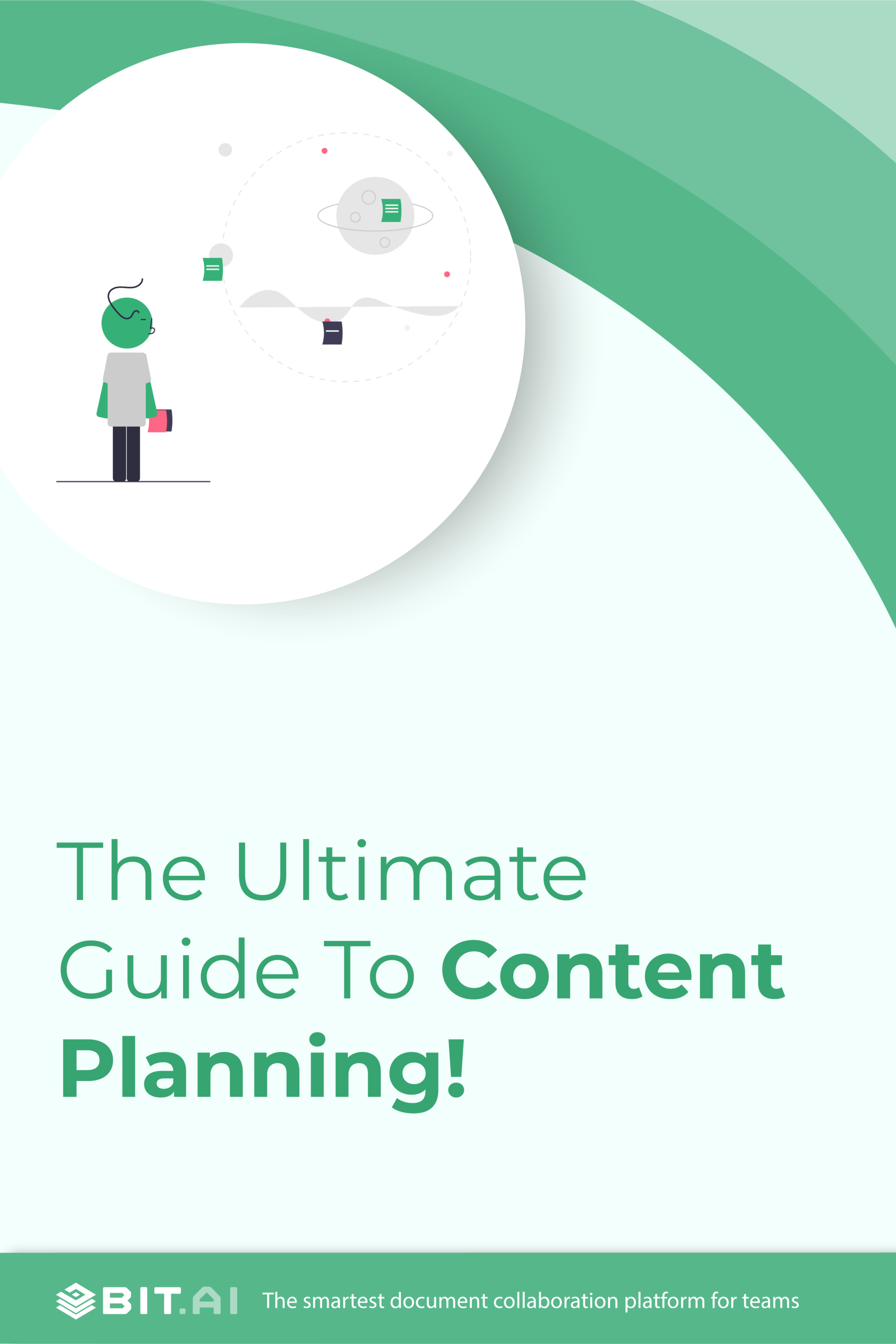Mark Twain once said, ‘The secret of getting ahead is getting started.’
When it comes to content planning, these words ring true. A well-thought-out strategy can be the catalyst that propels your blog from obscurity to the forefront of your readers’ minds.
As a budding blogger or content creator, you may find yourself standing at the starting line, filled with enthusiasm and a burning desire to share your ideas with the world. However, the path to success can often feel overwhelming and uncertain. That’s where content planning steps in, acting as your guiding light in this ever-expanding digital landscape.
Mark Twain’s timeless quote reminds us that taking that first step is crucial to moving forward. Just like an architect sketches the blueprint before construction begins, a well-crafted content plan is the foundation for your blog’s growth and success.
This blog post will cover the basics of content planning, including its definition, importance, elements, types, benefits, and a step-by-step process for creating an impactful content plan, enabling you to achieve your blogging goals effectively.
Let’s get started!
What is Content Planning?
Content planning is the strategic process of mapping out what content will be created, when it will be published, and where it will be distributed.
It involves developing a comprehensive content plan or editorial calendar that serves as a roadmap for prioritizing tasks, streamlining the content creation process, and tracking progress. Whether crafting engaging blog posts, captivating videos, or eye-catching visuals shared across platforms like Instagram, YouTube, or blogs, an effective content plan is vital to achieving your overall content strategy.
Now, content planning is a bit different from content strategy. While content strategy focuses on the big picture, the overall vision, and long-term goals for your content, content planning gets into the nitty-gritty details.
It’s like zooming in and figuring out the practical steps to bring your content strategy to life. It’s about answering questions like what kind of content you need, who your target audience is, what topics to cover, and when and how to publish and distribute your content effectively.
What is the Importance of Content Planning?
Content planning is rooted in understanding human psychology, audience behavior, and effective communication. It considers data analysis, market research, and customer insights to shape the content creation and distribution process.
So, why is it important?
First of all, content planning helps you stay on track with your business objectives. It ensures that your content aligns with what you’re trying to achieve and meets the needs of your target audience. It keeps things consistent and relevant.
Secondly, Content planning also helps you make the most out of every penny you invest. By strategizing the distribution of your content across different channels, you can optimize timing, format, and platforms to reach and engage your audience effectively.
Lastly, Content planning saves you from chaos and confusion. It’s like having a master plan that outlines what content you need, when to create it, and who will do what. No more scrambling around and wasting precious time. It’s all about being organized and efficient.
It also lets you measure and analyze your success. You can track how your content is performing, see what’s resonating with your audience, and make smart tweaks along the way.
The Elements of Content Planning
 Objectives
Objectives
Clearly define the objectives for your content, aligning them with your company’s goals and key performance indicators (KPIs). This ensures that your content planning process is purpose-driven and focused on achieving specific outcomes.
Client Persona
Develop detailed buyer personas that represent your target audience. Gather information about their demographics, behaviors, and preferences to create content that resonates with their needs and interests.
Buyer Journey Maps
Map out the stages and touchpoints of your customer’s journey with your brand. This helps you understand their specific needs at each stage and create content that guides and supports them throughout their decision-making process.
Workflows and Content Calendar
Establish efficient workflows and a well-organized content calendar to streamline content production and distribution. Clear processes, timelines, and responsibilities ensure smooth collaboration and timely execution of your content plan.
Onboarding and Training
Provide onboarding and training to internal and external stakeholders involved in the content planning process. This ensures that everyone understands the content plan, their roles, and the overall strategy, facilitating seamless collaboration and consistent execution.
Transparency and communication
Foster transparent and open communication among team members and stakeholders involved in content planning. This promotes effective collaboration, enables timely feedback and adjustments, and ensures everyone is aligned and working towards shared goals.
The Types of Content Planning?
When it comes to content planning, there are three main types that you should consider: brand awareness, keywords, and conversions.
Brand awareness
This type of content focuses on increasing the visibility and recognition of your company’s brand. It’s all about getting your name out there and educating potential customers about your company’s offerings. The key goal is building a positive reputation and introducing your brand to a wider audience. It’s about promoting specific products or services and highlighting your brand.
Keywords
This is where you create content that is optimized for specific keywords to drive organic traffic from search engines like Google. You can improve your website’s search engine rankings by strategically using these keywords in your content. It’s important to implement effective search engine optimization (SEO) strategies to ensure that your content ranks higher for the targeted keywords. Aligning your content with relevant keywords increases your chances of attracting more visitors to your website.
Conversions
 This type of content is all about driving results, such as generating sales or encouraging specific actions from your target audience. It’s geared towards individuals who are already interested in purchasing your products or taking a specific action. The content here makes a direct pitch for your brand, emphasizing its benefits and value. The goal is to convince your audience that choosing your brand is the right decision. Crafting conversion-focused content helps guide customers toward making a purchase or completing a desired action.
This type of content is all about driving results, such as generating sales or encouraging specific actions from your target audience. It’s geared towards individuals who are already interested in purchasing your products or taking a specific action. The content here makes a direct pitch for your brand, emphasizing its benefits and value. The goal is to convince your audience that choosing your brand is the right decision. Crafting conversion-focused content helps guide customers toward making a purchase or completing a desired action.
What are The Benefits of Content Planning?
Content planning offers several benefits that contribute to the success of your brand and content marketing efforts. These benefits include:
Fosters trust and connection
Through strategic content creation, you can establish a bond with your target audience by addressing their concerns and providing valuable information. You build trust and credibility by consistently delivering valuable content without expecting immediate returns, leading to a loyal community that trusts your brand over competitors.
Clarifies brand messaging
A well-executed content plan ensures that your brand message is effectively communicated. It allows you to define your narrative, maintain consistency across all communication channels, and shape the audience’s perception of your company, preventing misinterpretation or confusion.
Improves search engine rankings
A proper content plan is essential for achieving higher search engine rankings. By creating high-quality content that is optimized for relevant keywords, you can increase your organic visibility, attract more organic traffic, and boost your overall online presence.
Increases conversions
As your search rankings improve and more traffic visits your website or social platforms, you have a higher chance of converting those visitors into customers. Well-crafted content is crucial in driving conversions by establishing a personal connection with your audience and providing the information they need to make informed purchasing decisions.
Ensures consistency
Consistency is key in content marketing. With a content plan in place, you have a clear roadmap of what content to create and when to publish it. This enables you to maintain a consistent posting schedule, which builds audience expectations, strengthens brand awareness, and helps you achieve your content marketing goals effectively.
What Does Content Planning Involve?
In today’s dynamic work environment, performance reviews have become an indispensable tool for organizations and employees alike. When it comes to content planning, there are several key elements to consider to create a successful and effective strategy.
- Understanding audience needs: Content planning begins by deeply understanding the target audience, their preferences, and their pain points. This involves conducting market research, analyzing demographics, and identifying their interests and challenges.
- Defining goals and objectives: Clear goals and objectives provide direction for content planning. Whether brand awareness, lead generation, or thought leadership, setting specific and measurable goals helps shape the content strategy.
- Developing buyer personas: Creating buyer personas helps personify the target audience. These fictional representations include details such as demographics, motivations, and behavior patterns. Buyer personas are a reference point for tailoring content to specific audience segments.
- Conducting competitive analysis: Analyzing competitors’ content strategies provides valuable insights and inspiration. It involves evaluating their content types, formats, distribution channels, and engagement levels. This analysis helps identify opportunities to differentiate and improve the content plan.
- Content ideation and brainstorming: Generating creative and engaging content ideas is collaborative. Brainstorming sessions involving the content team, subject matter experts, and stakeholders can spark innovative concepts and perspectives.
- Content calendar creation: A content calendar acts as a content creation and distribution roadmap. It outlines the topics, formats, and publishing schedule. A well-structured content calendar ensures consistency, timely delivery, and efficient resource allocation.
How To Create a Content Plan?
A content plan works hand in hand with your content strategy, so let’s start by building a solid foundation. Here’s how to create your content plan, step by step.
Step 1: Develop a Clear Content Strategy
 Before we jump into the nitty-gritty of the content plan, it is essential to lay a solid foundation by establishing a well-defined content strategy. This is where you outline your goals using the SMART (Specific, Measurable, Attainable, Relevant, Time-Bound) approach.
Before we jump into the nitty-gritty of the content plan, it is essential to lay a solid foundation by establishing a well-defined content strategy. This is where you outline your goals using the SMART (Specific, Measurable, Attainable, Relevant, Time-Bound) approach.
For example,
- Increase website traffic by 20% within the next three months: This goal is specific (increasing website traffic), measurable (by 20%), attainable (within three months), relevant (to drive more visitors to the website), and time-bound (within a specific timeframe).
- Generate 100 leads through content downloads in the next quarter: This goal is specific (generating leads through content downloads), measurable (achieving 100 leads), attainable (within the next quarter), relevant (to grow the lead database), and time-bound (within a specific timeframe).
- Increase social media engagement by 30% over six months: This goal is specific (increasing social media engagement), measurable (by 30%), attainable (over six months), relevant (to boost brand visibility and interaction), and time-bound (within a specific timeframe).
Conducting thorough audience research is essential to ensure your content strategy hits the mark. Dive deep into understanding your target audience’s needs, preferences, and pain points. By gaining these valuable insights, you’ll be able to create content that truly resonates with your audience.
Step 2: Create a Content Plan Template
As a marketer, you’re probably creating content for social media, blog posts, and maybe even podcasts. It can get overwhelming to keep track of everything and ensure consistency, right? That’s where a content plan template comes to the rescue.
Each platform has its own unique requirements and audience expectations. By tailoring your template to fit these specific needs, you’ll be well-equipped to deliver quality content consistently.
 Consider including sections for captivating captions, eye-catching visuals, and relevant hashtags for social media. When it comes to blog posts, think about incorporating areas for attention-grabbing introductions, informative main points, and compelling conclusions. And if you’re venturing into the world of podcasts, outline segments, key discussion points, and any guest details.
Consider including sections for captivating captions, eye-catching visuals, and relevant hashtags for social media. When it comes to blog posts, think about incorporating areas for attention-grabbing introductions, informative main points, and compelling conclusions. And if you’re venturing into the world of podcasts, outline segments, key discussion points, and any guest details.
The beauty of having a content plan template is that you can reuse it repeatedly. Once your template is ready, you’ll see how it simplifies your content creation process and brings consistency to your work.
Remember, your content plan template aims to ensure that every piece of content you create meets the highest standards. It’s not about being formulaic or generic.
Step 3: Find the Right Topics
Finding the perfect topics for your content can be challenging, especially when you hit that creative roadblock. But don’t worry; there are plenty of ways to get those creative juices flowing again.
First, use various tools and resources that can be real lifesavers when you’re running out of ideas. Dive into keyword research tools to discover popular search terms and trending topics in your industry. This can give you valuable insights into what people are actively searching for and help you tailor your content accordingly.
Industry forums and online communities are also gold mines for topic inspiration. Engage in conversations, read through discussions, and see what questions people ask. These platforms offer a glimpse into your target audience’s real challenges and concerns, giving you a solid foundation to build your content.
Another great source of inspiration is social media. Keep an eye on the latest trends and discussions happening on platforms like Twitter, Instagram, and LinkedIn. Pay attention to what’s capturing your audience’s attention and use it as a springboard for your own content ideas.
Remember, finding the right topics is all about understanding your audience, their needs, and what resonates with them.
Step 4: Assign Tasks and Set Deadlines
Now that you have a clear content strategy and a template in place, it’s time to start the content creation process. Assigning tasks and setting deadlines is crucial for keeping everything organized and ensuring a smooth workflow.
First, identify the different components of your content plan, such as writing, designing, editing, and promoting. Each team member should clearly understand their responsibilities in the content creation process. Everyone plays a vital role, whether the writer crafting engaging blog posts, the designer creating eye-catching visuals, or the marketer promoting the content on various channels.
Once the tasks are defined, setting clear deadlines for each step is important. Deadlines help create a sense of urgency and accountability, ensuring that the work progresses smoothly and is completed on time. Communicate these deadlines clearly to everyone involved, allowing them to plan their work accordingly.
By assigning tasks and setting deadlines, you maintain an organized workflow and minimize the chances of any last-minute rush. Each team member can focus on their assigned tasks, knowing what needs to be accomplished and when. This collaborative approach fosters better teamwork and ensures everyone is on the same page.
Step 5: Schedule Content in Advance
Stay ahead of your content calendar to ensure a steady flow of engaging content for your audience. You can consider using content scheduling tools or platforms to simplify the scheduling process. These handy tools allow you to plan and automate the publishing of your content across various channels. You can set specific dates and times for your content to be released, ensuring it reaches your audience immediately.
This eliminates the need for last-minute content creation or scrambling to find something to share. Instead, you can focus on creating high-quality content in advance and let the scheduling tool take care of the rest.
Remember that while scheduling is essential, it’s also important to remain flexible. Things may change, new opportunities may arise, or you may receive timely news requiring your content calendar adjustments. Don’t be afraid to make modifications as needed.
Remember, creating and sharing content is an ongoing journey. Stay organized, adaptable, and responsive. With a consistent presence, you’ll be able to capture your audience’s attention.
Step 6: Measure and Analyze Results
 Now that your content plan is in full swing, it’s time to dive into the data and see how your efforts are paying off. This step is crucial for understanding the impact of your content and making informed decisions to improve future strategies.
Now that your content plan is in full swing, it’s time to dive into the data and see how your efforts are paying off. This step is crucial for understanding the impact of your content and making informed decisions to improve future strategies.
When it comes to measuring results, you want to keep a close eye on key performance indicators (KPIs) that reflect the success of your content. These can include metrics like website traffic, engagement levels, social media interactions, and conversions. Tracking these metrics gives you a clearer picture of how your audience responds to your content.
Analyzing the data will help you uncover valuable insights.
Are your website visitors on the rise? Is your audience actively interacting with your posts? Are your content efforts driving desired actions, such as newsletter sign-ups or sales?
By answering these questions, you can gauge your content plan’s effectiveness and identify improvement areas.
If you notice certain types of content performing exceptionally well, you can replicate that success in future campaigns. Conversely, if certain aspects fall short, you can adjust to better resonate with your audience.
Remember, your content plan is not set in stone. It’s a dynamic process that requires ongoing evaluation and fine-tuning. By analyzing the results, you’ll gain valuable insights into what’s working and what needs adjustment, enabling you to optimize your content strategies for even greater success.
Let the data be your guide, and don’t be afraid to experiment and iterate based on what you discover.
Looking to streamline your content planning?
Consider exploring Bit.ai’s Content Planning Template. This template provides a structured framework for organizing your content creation process, ensuring a smooth workflow and improved organization. Whether you’re a content creator or a marketer, incorporating Bit.ai’s Content Planning Template can greatly enhance your efficiency and effectiveness. Take a moment to check it out
Wrapping Up
Content planning blends the art of storytelling with the science of audience engagement, ensuring that your content resonates with your target audience, maximizes impact, and drives desired outcomes for your business.
Think of content planning as the tactical side of things, where you create a detailed roadmap to guide your content creation and distribution efforts. It’s all about being organized and having a clear plan in place to achieve your objectives.
When you encounter a company that consistently produces exceptional content, they likely have a stellar content plan in place, backed by practical implementation.
Happy creating!
Further Reads:
Using Artificial Intelligence (AI) in Content Marketing To Analyze Data!
Content Strategy Framework: Unlocking Success With This Guide!
How ChatGPT Can Help You Create Content? A Quick Overview!
Content Syndication: What is it & How it Works? (Examples)
Short-Form Video Content That Are Trending in 2023!

Related posts
Bit.ai | Watch to Learn More
What is Bit.ai?
Bit.ai is an innovative AI-driven knowledge and Document Managment suite designed to empower knowledge workers by streamlining the creation of, documents, wikis, and notes. With an intuitive interface and seamless integration, Bit.ai acts as a versatile assistant to help you collaborate, generate, organize, and visualize your ideas effortlessly. Whether you are drafting a report, managing a project, collaborating with your team or clients, or brainstorming new concepts, Bit.ai brings intelligence and creativity to every aspect of your work process.


